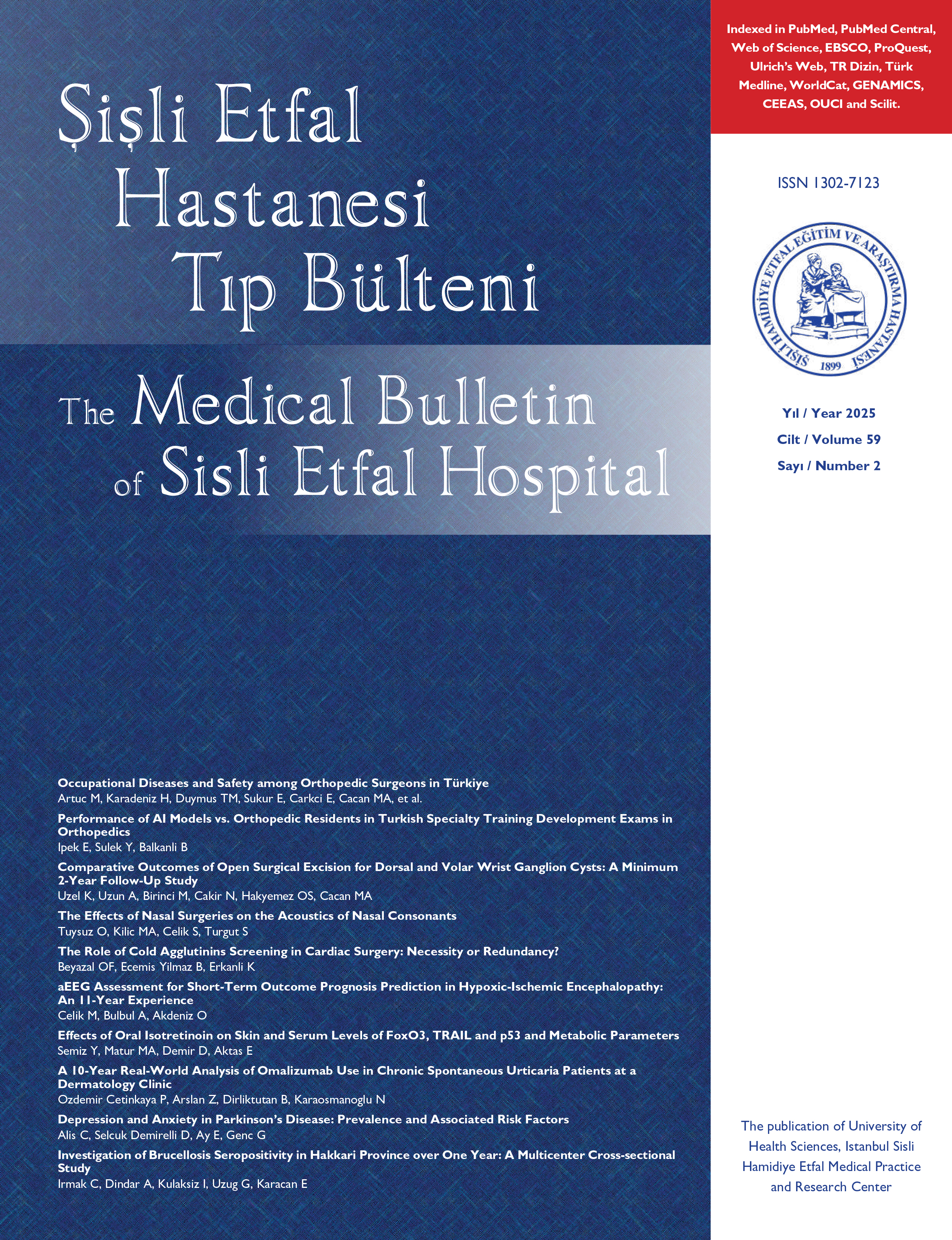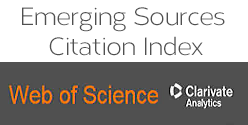
Volume: 37 Issue: 2 - 2003
| CASE REPORT | |
| 1. | Modern refractive surgery: LASİK (Laser in situ Keratomileusis) Ersin Oba, Aytekin Apil, Hasan Vatansever Pages 9 - 10 Abstract | |
| 2. | Emergency therapy management in organophosphate intoxication Ayda Başgül, Sevtap Hekimoğlu, Ayşe Hancı, Sibel Oba, Birsen Ekşioğlu Pages 11 - 14 Introduction: Organophosphate insecticide was first described by Du Bois in 1948. Organophosphates irreversibly, carbamates reversibly binding to acetylcholinesterase, they form the clinical presendation by causing the cumulation of acetylcholin which is vital neurotransmitter in both Centrale Nerve System and Otonomic Nerve System in cholinergic sinapses. Case Report: 23 years old female patient, when brought to the emergency room, has taken a half tea bottle Dicklorvos insecticide containing one hour before with oral route. She had no complaint, exit of stomach ache and nausea. She had undergo¬ne early gastrointesthinal decontamination. She was evaluated by us because of she has been confusion, sweating and flushing. Atropin and pralidoxime management was started ourself. We have not sufficient dose of pralidoxime there fore it was started in a very low dose than offered in the literature. Conclusion: Organophosphate intoxications are life treatening events. We came to a conclusion that even early gastrointesthinal decontamination and single dose 200mg pralidoxime + 1 mg atropine IV manegement could be useful. Organophosphates in toxication are events treating of life. |
| ORIGINAL RESEARCH | |
| 3. | Neutrophil hypersegmentation in iron deficiency anemia Serpil Düzgün, Yıldız Yıldırmak, Feyzullah Çetinkaya, Günsel Kutluk, Metin Uysalol, Merih Akışık, Reyhan Yıldırım Pages 15 - 20 Objective: Neutrophil hypersegmentation is an expected pe¬ripheral blood smear finding in megaloblastic anemias. Cli¬nical reports suggest that neutrophil hypersegmentation may also occur in patients with iron deficiency anemia. In this study we searched presence of neutrophil hypersegmentation in patients with iron deficiency anemia but have normal vitamin B12 and folic acid levels. Study Design: The subjects (n: 123) were divided into two groups: the patients with iron deficiency anemia constituted Group I (n: l()2), and the healthy controls Group II (n: 2l). The average ages and sexuality of both groups were comparative. Results: Hypersegmentation was found in 30.4 % of Group I and 9.5% of Group II (p<0.05). Conclusion: These results show that neutrophil hyperseg¬mentation may also be seen in patients with iron deficiency anemia. |
| 4. | Comparison of three antibacterial regimens in the treatment of tonsillopharyngitis due to beta-hemolytic strepto cocci in children Zeki Toplu, Günsel Kutluk, Feyzullah Çetinkaya, Metin Uysalol, Merih Akışık Pages 21 - 24 Objective: Comparison of the efficacy of oral penicillin, clarithromycin and azithromycin in the treatment of patients with tonsillopharyngitis due to group Afihemolytic streptococcus (GABHS) in throat cultures. Patients and methods: The study included 60 patients diagnosed with acute tonsillopharyngitis whose throat cultures revealed GABHS. These patients were divided randomly and equally into three groups. First group was treated with oral penicillin and the second group with clarithromycin for 10 days. The third group was treated with azithromycin for 3 days. The efficacy of treatment was evaluated by the presence or absence of growth in throat cultures done 3-7 days after the completion of the therapy. Results: Bacterial eradication was achieved in 19 patients in the penicillin (95 %) and in all of the patients (100 %) in clarithromycin and azithoromycin groups. There were no statistically significant differences between the groups in regard to bacterial eradication rate. (P > 0.05). Conclusion: It is concluded that azithromycin and clarithromycin can also be effectively used as well as conventional oral penicillin in the bacterial eradication and treatment of GABHS tonsillopharyngitis. |
| 5. | The incidence of retinopathy among premature babies and zone-grade relationship in ROP diagnosed eyes Aytekin Apil, Hasan Vatansever, Ersin Oba, B. Buğra Akdemir Pages 25 - 29 Objective: To identify the Retinopathy of Prematurity (ROP) incidence in premature babies according to gestational week and gestational weight, and to determine the relationship between zone and grade. Methods: 1050 eyes of 525 babies with birth weight ranging from 540 to 2650 gr, gestational week ranging from 26 to 36 weeks were included in this study.Pupils were dilated with topical %0.5 cyclopentolate and %2.5 phenylephrine before examination of ocular fundus using indirect ophthalmoscopy with scleral depression. Babies were divided into two groups according to gestational week and weight and ROP incidence was found in each group. Zone and grade relationship were also detected in affected eyes. Results: Overall incidence of ROP was 219 of 525 eyes (%41.7) and 41 babies (%7.8) were referred to Ophthalmological Department of Istanbul Universities of Faculty of Medicine for further treatment.Threshold disease was found in eyes of babies greater than 34 gestational week and 1680 gr of gestational weight.There was ROP in all babies less than 750 gr but over 2000 gr ROP was observed in two of 28 babies..Overall ROP was detected in 428 eyes.Among these eyes, the most frequent regression of ROP was from grade II in 188 eyes (%43.92) and regression was seen most frequently in 291 eyes in zone III (%67.99). Conclusion: There are different results of many studies about ROP incidende according to gestational week and weight. The threshold disease is mostly seen in low birth weight and week premature babies. But very rarely it may be also seen in babies over 2500 gr of weight. Our study shows that it is impossible to draw confidently the upper border of gestational week and weight of ROP during examination. |
| CASE REPORT | |
| 6. | Polyglandular autoimmune syndrome TYPE III Cemal Bes, S. Kerem Okutur, Ç. Yazıcı Ersoy, B. Tolga Konduk Pages 30 - 33 Polyglandular autoimmune syndrome (PAS), comprise up of autoimmune disorders of the endocrine glands suits in failure of the glands to produce their horn, distinguishes two broad categories, type I and type II ditional group, PAS type III, subsequently is descri characterized by autoimmune thyroid disease, insulii dent diabetes mellitus (1DDM), pernicious anemia, and other autoimmune disorders. PAS type III, is see and in contrast to PAS type I and II, it does not in\ adrenal cortex. Here we presented a patient with autc thyroid disease and pernicious anemia (PAS type Illb, observed in our clinic. |
| ORIGINAL RESEARCH | |
| 7. | Gastrointestinal perforations seen in childhood Mustafa İnan, Burhan Aksu, Çağatay Yalçın Aydıner, Mehmet Pul Pages 34 - 38 Objective: The aim of this study was to evaluate our a gastrointestinal perforation with the literature Study Design: This study was carried out retrospectr 35 children who were diagnosed and treated for gastroi nal perforations, from 1994 to 2002. The cases were c, ed into three groups as newborns, infants, and older ch Results: In newborn group, gastrointestinal perforation frequently observed in ileum (n=9) due to necrotizing t colitis (n=10). Ileostomy (n=8) were performed and me rate was 35.2% in this group. In infant group, one st and one colon perforation were observed and the perfc zone could not be detected in one patient. Only one / survived in this group. In children group, blunt abdomir uma (n=4) and corrosive intake (n=4) were the most ce causes of perforation. Primary suture (n=6) were per] for this groups cases and mortality rate was 26,6%. Conclusion: The advances of medical technologies up\ the diagnosis, treatment, and follow-up of childhood ga testinal perforations. However, today, gastrointestinal rations still remains to be a life-threatening condit childhood. Early diagnosis and appropriate surgical vention are the most important factors for decreasing, lity rates of this problem. |
| 8. | The levels of Antithrombin III and D-Dimer as indicator of coagulation and fibrinolytic activity in diabetes mellitus Işık Türkalp, Naciye Erzengin, Hilal Sekban Pages 39 - 45 Objective: This study was done in order to investigate coagula¬tion and fibrinolytic activity in patients with diabetes mellitus, in addition to detect the relationship between glycometabolic control and coagulation activity and fibrinolysis in diabetics. Study design: We determined levels of ATH III, D-dimer, and FDP in 20 healthy subjects and 35 diabetic patients with complications and we examined the correlations between HbAlc and ATH III and D-dimer. Results: Compared to the control subjects, we found signifi¬cantly increased ATH III and D-dimer levels in patienlts with diabetes mellitus (p<0.0060 and p<0.001, respectively). Clini¬cally relevant increases in FDP levels were observed in diabe¬tics (p<0.050). In patients with good and poor glucose control, we noted significant differences between HbAlc and fasting blood sugar (p<0.000 and p<0.000, respectively). There was a moderate correlation between HbAlc and ATH III in all diabe¬tics (r-0.49, p<0.03); similarly a moderate correlation betwe¬en HbAlc and ATH III was found in patients with poor glucose control (r=0.47, p <0.048). Parallel to this finding, we detected higher ATH III levels in patients with poor glucose control (%112.83±23 versus %100.71±19). No statistically significant relationship was found between HbAlc and D-dimer levels. D- dimer levels in patients with good and poor glucose control were 0.47±0.27 pg/ml and 0.56±0.40 pg/ml, respectively. In patients with complications of diabetes mellitus, a slight corre¬lation was noted between age and D-dimer levels (r-0.4167, p<0.013), whereas there was no correlation between age and ATH III. Conclusion: In view of our results, we concluded that coagula¬tion and fibrinolytic activity increased in patients with diabetes mellitus, with even more increases in coagulation activity in those with poor glucose control. The relationship between the glycometabolic control and fibrinolytic activity could not be demonstrated using HbAlc levels. |
| 9. | Radiological approach to Crouzons Syndrome İrfan Çelebi, Barış Yanbuloğlu, Tuğser Hakan Doğan, Ayhan Üçgül, Seniha Aktaş, Muzaffer Başak Pages 46 - 49 Objective: The aim of this study is to discuss radiological approach to Crouzon syndrome which early diagnosis and treatment is important. Study Design: A three-month old baby that was born by nor¬mal vaginal delivery on due time was admitted to our clinic from the department of neurosurgery due to abnormal head shape.The case was evaluated by conventional graphy of the cranium, transcranial color Doppler sonography (CDS), computed tomography (CT), three dimensional reconstructi- onal computed tomography (3D CT) and by magnetic reso¬nance imaging (MRI). Results: Among all the modalities were used, 3D CT was the most valuable diagnostic tool in the demonstrating the fusion of the sutures and also position of the orbita relative to the anterior cranial fossa.. Transcranial CDS is a noninvasive technique for determining intracranial pressure changes and also post-operative follow up. Conclusion: The intracranial pressure build up that observed in Crouzon Syndrome,may cause the pressure atrophy in bra¬in paranchyma and impairment of neuromotor development. By using the modern imaging techniques, this disease can be diagnosed clearly. |
| CASE REPORT | |
| 10. | Stab wounds to the gluteal region: A management strategy Halil Coşkun, Tiilay Eroğlu, Uygar Demir, Burhan Gündüz, Mehmet Mihmanlı Pages 50 - 53 Stab wounds to the gluteal region are uncommon and potentially lethal, and the location of injury influences the rate and severity of associated injuries. We report an unusual case of a inferior gluteal artery rupture without stab wounds. Angiography revealed an injured inferior gluteal artery, which was successfully embolized. |
| 11. | Hemophilic pseudotumor of the femur Ahmet Mesrur Halefoğlu, Muhammet Acar Pages 54 - 56 Pseudotumors are rarely seen in hemophilia cases and can lead to some diagnostic difficulties due to mimicking real bo¬ne tumors. Magnetic Resonance Imaging is a very useful and sensitive modality for the diagnosis of these kinds of lesions. It provides important information about the hemophilic pse¬udotumors by revealing blood products of various stages in the lesion and is also helpful in therapeutic decision-making. In our case We used Magnetic Resonance Imaging modality for diagnosing a right femur hemophilic pseudotumor and have been able to show characteristic blood products of this lesion which was pathognomonic for a pseudotumor in a hemophilia case. |
| 12. | Our first foot replantation case Kemal Uğurlu, Ayşin Karasoy, Onur Egemen, Bülent Aksoy, Lütfü Baş Pages 57 - 60 Replantations after traumatic amputations of the lower extremity are long, complicated operations requiring a team with microsurgery experience. Although the prothesis for lower extremity are well developed, they cannot replace the replan- tated extremity functionally and aesthetically. In this paper we present the first lower extremity replantation case in our hospital and knowledge of literature about this subject. |



















